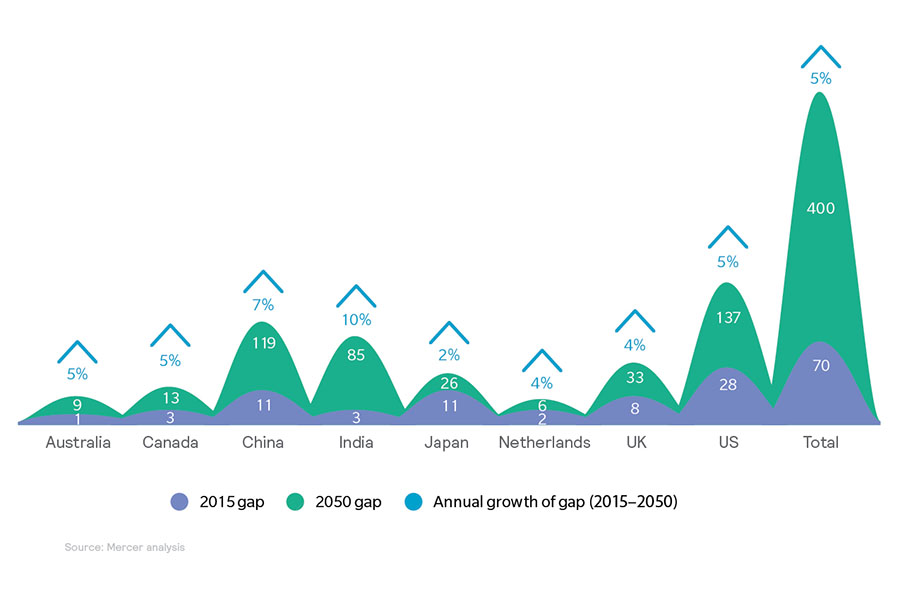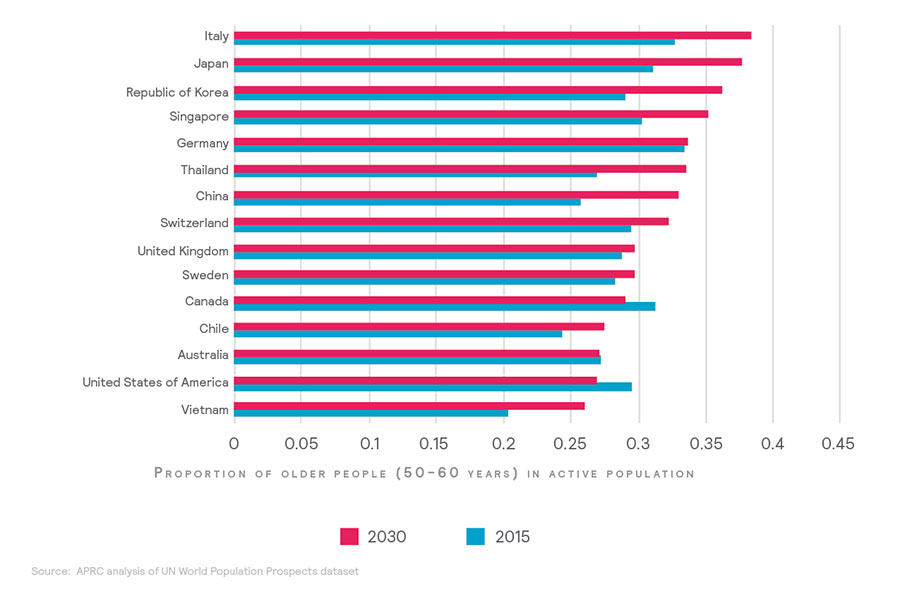“Almost 60% of workers aged 45-plus are investing in new skills for work, with the majority reporting positivity and excitement about their jobs.”
Homemade soup dumplings, lovingly knitted socks for the grandchildren, and a one-woman e-marketing firm specializing in AI storytelling for global brands. Being a grandparent isn’t what it used to be.
Many nations have already seen a steady increase in the median ages of their workforces, and this trend is largely expected to continue into the coming decade. Retirement-savings gaps (the difference between retirement costs-of-living and savings for retirement), are widening dramatically throughout the world, due to longer life expectancies and inadequate retirement savings programs. Analysis of this phenomenon shows that this gap stood at $70 trillion globally in 2015 and is projected to reach $400 trillion by 2050[1]. These wide gaps are a powerful motivator behind older workers returning to or remaining in the workforce.

While well-documented statistics about people living longer and healthier lives abound—the retirement gap is real—commonly overlooked, is the evolving relationship aging people have with work—actually, perhaps not work, but life.
A New Era of Relevance
The image of an aging worker blowing out candles in a bland conference room and reading heartfelt memos scribbled on a “Congratulations on Retiring!” card belongs in the past. Save the applause. Forget the cake. There may be no speech. Older workers are increasingly opting out of the ceremonies designed to mark their passage into the “golden years”. The elderly are forging their own futures and disrupting one of life’s most harmful clichés: aging is a process of declining relevance.
Today’s aging population thinks differently. While financial reasons are the most common motivation, older workers also frequently cite non-financial reasons for remaining in the workforce, including the desire to stay healthy and active, and taking pride and finding self-fulfillment in their work[2]. Almost 60% of workers aged 45-plus are investing in new skills for work, with the majority reporting positivity and excitement about their jobs[3].
The idea of retirement is blasé, if not downright insulting. What does it say about a person who celebrates retirement because they’ve spent the last 45 years doing something they’d prefer not to be doing? Sure, few people like waking up and trudging off to work on a Monday morning, but this small act of self-determination connects them with millions of other workers who share the same experience. That connection brings relevance, dignity and a sense of purpose. Older people know that going to work is a blessing, not a curse. And workers around retirement age are discovering that employment—and the relevance it brings—is now, more than ever, something they can customize to suit their lives.

Inspiration Is Ageless
Inspiration is not exclusive to youth. American Charles Flint founded IBM at the age of 61. French post-impressionist painter Cézanne created his most valuable work in his late 60s. After discovering early retirement wasn’t for him, tech entrepreneur Bob Parsons started the Internet domain registrar and web hosting company, GoDaddy at age 47. The same dreams young entrepreneurs have of making a profound impact on the world are the same motivations that drive older entrepreneurs. It is human nature to want to make a difference, to be respected, to matter. Now, with advances in technology connecting people and opportunities more than ever, aging employees are exposed to career options that didn’t exist 20, or 10, or 5 years ago. Technology keeps changing, and older people—contrary to popular opinion—are better equipped to navigate change because they’ve seen it and lived through it.
Few of the world’s most renowned entrepreneurs achieved success without having to endure struggles and challenges. Steve Jobs was fired from his own company. Jack Ma, cofounder of Alibaba, was rejected from 30 different jobs that he applied for—including a position at Kentucky Fried Chicken, which was founded by Harland David Sanders at the age of 65! Inspiration arrives via many ways and in many incarnations—as a fleeting thought while taking a shower or as the result of decades of grueling work in a particular industry. Regardless of the means or the circumstances, inspiration has never—despite cultural assumptions—been determined by age. The reason many older people do not act on their inspired moments is because society expects less—or perhaps something different—from them. Times are changing.
The Essentials of Entrepreneurship
Entrepreneurialism requires three essential attributes: confidence, ability, and perspective. Older workers possess copious amounts of each. Younger people may exhibit confidence, but that bravado is often rooted in hopeful exuberance—and probably some naiveté—from not knowing how closely misfortune looms. (Luck is more arbitrary than anyone cares to admit.) Older people offer confidence rooted in knowledge gained through time and experience. Real confidence. The kind that comes from having enjoyed the best, and survived the worst, of times. Aging workers also possess true abilities and can prove it by reflecting on long careers that taught them skills, talents, and ways of thinking that can only be gained through experience. People who think older people do not have the ability to learn new technologies are practicing ageism—which is not only a myopic perspective, but illegal in many countries.
Finally, entrepreneurship requires a bold perspective—to take risks, to close your eyes and let go. Prevailing wisdom states that younger people, especially people in their 20s, are naturally open to risk because they have more time and fewer responsibilities; if a business venture fails, they can rebound. But nothing opens up the human soul to risk more than the knowledge that mortality is real, and looming. Aging workers are increasingly empowered to take control of their own destinies. After the Great Recession of 2008, countless older workers opened their laptops, created websites, and started their own businesses, consultancies, and organizations. It is only a matter of time before the next aging worker becomes inspired and changes the world in unprecedented ways. Older people know that anything can happen in life. Just ask Jack Ma, who at 53 years old could be selling fried chicken in his hometown, but is instead the co-founder and executive chairman of Alibaba Group, a multinational technology conglomerate, and one of the most admired companies by Fortune.
As people prepare for uncertain times ahead, it is crucial organizations also plan for the demographic changes that parallel. Older people are indeed becoming more willing and able to engage in meaningful work, and companies would do well to incorporate older workers into their workforce of the future strategies.
1World Economic Forum (2017). We’ll Live to 100 – How Can We Afford It?
2Asia Pacific Risk Center (2017). Aging Workforce
3Lynda Gratton and Andrew Scott (2016). The 100 Year Life
4European Commission (2015). Employment of older workers; The Centre on Aging & Work at Boston College (2005). Older Workers: What Keeps Them Working?







